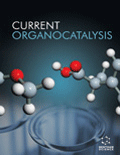- Home
- A-Z Publications
- Current Organocatalysis
- Previous Issues
- Volume 4, Issue 1, 2017
Current Organocatalysis - Volume 4, Issue 1, 2017
Volume 4, Issue 1, 2017
-
-
Chiral Ionic Liquids: Synthesis and Role as Efficient Green Catalyst in Asymmetric Synthesis
More LessAuthors: Soumen Payra, Arijit Saha and Subhash BanerjeeBackground: Over the past decade, catalysis by ionic liquids (ILs), has gained much attention, due to its variety in catalytic reactions that have been successfully carried out in such clean media for green chemistry, especially in synthetic and catalytic transformations. Catalysis in ILs is one of the most promising greener reactions in catalytic science. ILs, have several advantages, that they are used as alternative solvents in the pro Read More
-
-
-
Recent Advances in Utilities of Active Iodine Reagents as Organo- Catalysts in Organic Synthesis
More LessAuthors: Guo-Lin Gao and Qian ChenSince 1990s, the application of organo-iodine reagents as oxidant in organic synthesis went through explosive progress. In early times, most of organo-iodine reagents were used as stoichiometric terminal or co-oxidants in oxidative reactions, which inevitably led a lower atom coefficient of utilization and environmental issues. In this regard, it is very urgent to develop varies of efficient approaches of the catalytic utilization o Read More
-
-
-
Organic Polymeric Resins Embedded with Pd NPs: Newly Designed, Efficient and Chemoselective Catalyst for Reduction of Nitrobenzenes
More LessAuthors: Basudeb Basu, Susmita Paul, Samir Kundu, Emil Byström, Knut Irgum and Fredrik AlmqvistBackground: Organic polymer supported palladium nanoparticles (NPs) are important for use as heterogeneous catalyst in various organic reactions. This works describes Pd Nps immobilized on to polystyrene-based ion-exchange resin surface for use as catalyst in the reduction of nitrobenzenes. The heterogeneous catalyst was found useful for hydrogenation of nitro group under both catalytic transfer hydrogenati Read More
-
-
-
Oxidation of Alcohols by Hydrogen Peroxide Catalyzed by Trinuclear Copper(II) Complex [Cu3(slmh)(μ-Cl)2(CH3OH)3].0.5CH3OH derived from Disalicylaldehyde Malonoyldihydrazone
More LessBackground: The oxidation of alcohols to afford carbonyl compounds is a key transformation in organic chemistry. Significant development has occurred in the recent years, in catalytic oxidation of alcohols by aerial oxygen. However, the alcohol oxidation mediated by H2O2 is quite meagre. From economic and environmental point of views, the oxidation of alcohols mediated by H2O2 is quite attractive in particular. Methods: Read More
-
-
-
Efficient and Green Synthetic Protocol for the Synthesis of Structurally Diverse Spiroheterocycles using GAAS as Catalytic Solvent
More LessAuthors: Sarita Khandelwal, Anshu Rajawat, Yogesh Kumar Tailor, Anju Kulhari and Mahendra KumarBackground: The development of novel synthetic methods for the synthesis of structurally diverse drug-like molecules with environmentally friendly solvents and catalysts is significant in the development of drug discovery research. The synthesis of fused heterocycles has attracted considerable interest because the fusion of biologically active heterocyclic systems has proved to be an attractive and useful approach for designing Read More
-
-
-
Fe3O4@SiO2 Nanoparticles Decorated with Schiff base Complex of Pd(II) as a Magnetically Phosphine-free Catalyst for Heck-Mizoroki Coupling Reactions
More LessAuthors: Esmaeilpour Mohsen and Sardarian A. RezaBackground: The palladium-catalyzed couplings of alkenes with aryl halides is considered as one of the most important methods for carbon-carbon bond formation and have been utilized in the areas of natural products, high performance materials, bioactive compounds, new drugs and many industrially useful chemicals. Although the homogeneous palladium catalysts offer several advantages concerning higher selectivity and Read More
-
Most Read This Month
Article
content/journals/cocat
Journal
10
5
false
en

Most Cited Most Cited RSS feed
-
-
Liquid Membranes in Catalysis
Authors: Muhammad W. Ashraf and M. Amin Mir
-
- More Less

